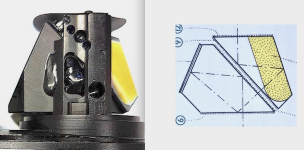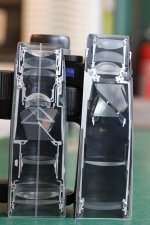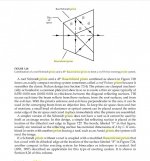jan van daalen
Well-known member
Hi Jan,
Is the last drawing of the eyepiece correct, or was the middle lens reversed after the drawing was made?
Also, how are the prisms oriented in the photos? Is the eyepiece end of the prism assembly up or down? Which prism in the Retrovid has the roof edge in the last photo? Is it the one on the left or the right side of the prism assembly as it appears in the photo? I'm asking because the roof can be in either of the two prisms and the the light path can travel through the prisms in either direction. I'm not quite certain from the photos which of the four possible configurations is being used.
Thanks,
Henry
Hi Henry,
These are very good questions. Specially the first one:t:
The bin was already in pieces by the time we came (he had to make special tools to open it) so I don't know the answer on your second question also.
I'll call him monday.
It is possible that he reads this and mails me sooner.
Jan








